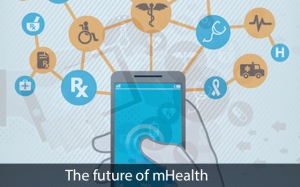 Various researches have indicated the various benefits which implementation of mHealth is to bring forth in the healthcare industry. Although there is an inclination to quantify the benefits in monetary terms, the real focus should be on identifying the major changes in healthcare delivery which mHealth is going to bring about. The accuracy of monetary benefits is always going to be debatable but not the tangible benefits drawn from mHealth adoption. Of the many benefits predicted two areas which are going to see some real changes are remote patient monitoring and chronic disease management. In the event of the first, it will result in patients spending less time in hospitals and in outpatient visits. What has been really exciting is to have mHealth hardware getting directly linked to companion apps.
Various researches have indicated the various benefits which implementation of mHealth is to bring forth in the healthcare industry. Although there is an inclination to quantify the benefits in monetary terms, the real focus should be on identifying the major changes in healthcare delivery which mHealth is going to bring about. The accuracy of monetary benefits is always going to be debatable but not the tangible benefits drawn from mHealth adoption. Of the many benefits predicted two areas which are going to see some real changes are remote patient monitoring and chronic disease management. In the event of the first, it will result in patients spending less time in hospitals and in outpatient visits. What has been really exciting is to have mHealth hardware getting directly linked to companion apps.
However, mHealth is expected to grow more so as Smartphone-based rather than being delivered through bespoke devices. As far as chronic disease management is concerned, from addressing high healthcare costs, inequality of care and medicinal waste, mHealth can actually bring about some serious positive change in lifestyle. Plus, it allows patients in some capacity to manage their health independently. For a chronic disease like diabetes, triggered mainly by incorrect lifestyle, mHealth can prove a really meaningful contribution in managing it well. For e.g. patients can use the proven apps to adhere to treatment regimes. Physicians can use make use of Patient portals to communicate directly with patients and provide information on disease management. All these and many more channels can be used to get patients to manage their blood glucose levels and reduce instances of emergency room visits and readmissions. Studies done have also indicated that with the younger lot, who unfortunately suffer from the disease, there are apps specially designed which use pictures and text messages which engage them to improve their compliance to care process at home. Also, it helps to get responses to queries from physicians in quick time. The texting program has seems to be gaining in popularity with text reminders ensuring better adherence.
Overall, these are early stages for adoption of mHealth apps. Most of the ones available currently do not have a high degree of sophistication, and are underutilized. However, it is laying the foundation for the next level of innovation to follow where the apps developed will be more suited to the changing healthcare landscape. Since a lot of changes related to healthcare IT are scheduled in the next few years, with some mandated by the federal government, the mobiles apps in the future will have to take into account the regulatory compliances to pervade into the lives of all stakeholders in the industry. The mHealth market is entirely in sync with the smartphone application market. Hence, the adoption is sure to pick from developed countries before it moves to others. In absolute terms, mHealth will see a exponential adoption since the number of people using smartphones and tablets is expected to be in billions in the next 5 years. That is also the time when it is expected to have entered the commercialization phase. But between then and now some major changes will also have to be done. For instance the regulations will have to be modified and defined in clear terms and the solutions have to handle more complex situations. The changes currently taking place in the operational models in the industry will create a an environment conducive to mHealth adoption. One of the studies done to identify the trends which will shape the market for mHealth had the following points to share
- The main driver for the mHealth usage will be the penetration of Smartphones
- There will customized mHealth applications available for smartphones or tablets
- Most of the applications will be native
- There are likely to be niche stores for mHealth apps
- The commercialization phase will require better regulations to be in place
- The market will be driven by the buyers
- The traditional health distribution channels will start adopting mHealth apps
- Countries with high smartphone penetration and healthcare budgets will be the main benefactors
- The chronic diseases will draw special focus
- New business models will come into play
With the adoption rate for mHealth apps on the rise, healthcare software testing also starts assuming increasing importance. It becomes vital and hence imperative to use app testers to test the robustness and security of the apps before they are rolled out to the patients and users.
We provide Healthcare software development services. To know more about the expertise of our healthcare application developers, please visit Mindfire Solutions.

